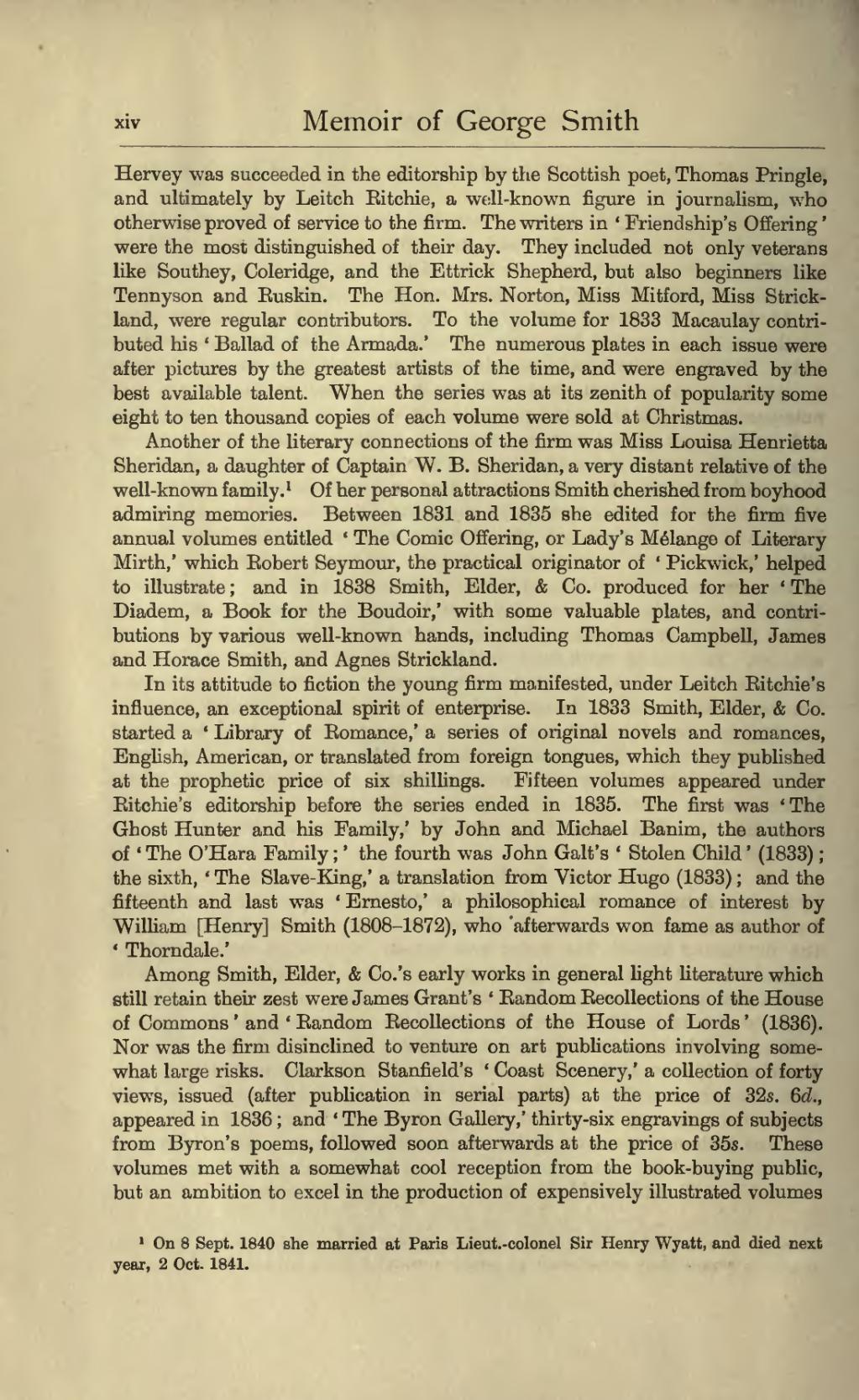Hervey was succeeded in the editorship by the Scottish poet, Thomas Pringle, and ultimately by Leitch Ritchie, a well-known figure in journalism, who otherwise proved of service to the firm. The writers in ‘Friendship's Offering’ were the most distinguished of their day. They included not only veterans like Southey, Coleridge, and the Ettrick Shepherd, but also beginners like Tennyson and Ruskin. The Hon. Mrs. Norton, Miss Mitford, Miss Strickland, were regular contributors. To the volume for 1833 Macaulay contributed his ‘Ballad of the Armada.’ The numerous plates in each issue were after pictures by the greatest artists of the time, and were engraved by the best available talent. When the series was at its zenith of popularity some eight to ten thousand copies of each volume were sold at Christmas.
Another of the literary connections of the firm was Miss Louisa Henrietta Sheridan, a daughter of Captain W. B. Sheridan, a very distant relative of the well-known family.[1] Of her personal attractions Smith cherished from boyhood admiring memories. Between 1831 and 1835 she edited for the firm five annual volumes entitled ‘The Comic Offering, or Lady's Mélange of Literary Mirth,’ which Robert Seymour, the practical originator of ‘Pickwick,’ helped to illustrate ; and in 1838 Smith, Elder, & Co. produced for her ‘The Diadem, a Book for the Boudoir,’ with some valuable plates, and contributions by various well-known hands, including Thomas Campbell, James and Horace Smith, and Agnes Strickland.
In its attitude to fiction the young firm manifested, under Leitch Ritchie's influence, an exceptional spirit of enterprise. In 1833 Smith, Elder, & Co. started a ‘Library of Romance,’ a series of original novels and romances, English, American, or translated from foreign tongues, which they published at the prophetic price of six shillings. Fifteen volumes appeared under Ritchie's editorship before the series ended in 1835. The first was ‘The Ghost Hunter and his Family,’ by John and Michael Banim, the authors of ‘The O'Hara Family;’ the fourth was John Galt's ‘Stolen Child’ (1833) ; the sixth, ‘The Slave-King,’ a translation from Victor Hugo (1833) ; and the fifteenth and last was ‘Ernesto,’ a philosophical romance of interest by William [Henry] Smith (1808-1872), who afterwards won fame as author of ‘Thorndale.’
Among Smith, Elder, & Co.'s early works in general light literature which still retain their zest were James Grant's ‘Random Recollections of the House of Commons’ and ‘Random Recollections of the House of Lords’ (1836). Nor was the firm disinclined to venture on art publications involving somewhat large risks. Clarkson Stanfield's ‘Coast Scenery,’ a collection of forty views, issued (after publication in serial parts) at the price of 32s. 6d., appeared in 1836 ; and ‘The Byron Gallery,’ thirty-six engravings of subjects from Byron's poems, followed soon afterwards at the price of 35s. These volumes met with a somewhat cool reception from the book-buying public, but an ambition to excel in the production of expensively illustrated volumes
- ↑ On 8 Sept. 1840 she married at Paris Lieut.-colonel Sir Henry Wyatt, and died next year, 2 Oct. 1841.

